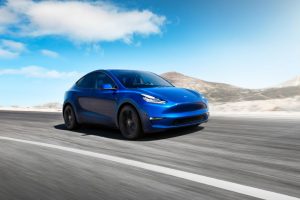We’re in the midst of a major technological shift in the way we transport people and goods, the likes of which we haven’t seen since we first embraced Henry Ford’s new invention and let our horses focus on showjumping. I’m talking about the shift from gas-powered to electric vehicles (EVs). These upgraded cars, trucks, and buses might look like their smog-spewing counterparts, but they’re really a power-packed clean transportation solution that can help curb global warming emissions as we continue to combat the climate crisis, reduce health-harming tailpipe pollution, and save drivers money on fuel and at the shop. EVs benefit everyone, but especially those who have to travel further in their everyday lives. Learn more about information on EV benefits in your state here.

Rural drivers spend more time on the road—so stand to save more by driving electric
This one might seem like it goes without saying, but I’ll go ahead and say it anyway: more driving equals more money spent on fuel and maintenance. With their work, school, grocery store, and doctor’s office being further away, rural drivers can save up to twice as much as their city-dwelling counterparts by switching to an EV. I spoke with Dr. Robert Leese, a retired family practice physician and EV driver from Springfield, New Hampshire, who said he was eager to buy his Nissan Leaf back in 2016 not only because of these fuel savings, but because of the public health implications of driving gas-powered vehicles. “Burning more fossil fuels leads to increased pediatric hospitalizations and deaths from asthma all over this country. I wanted to do my part to reduce these impacts, I didn’t even realize at first how much money I’d be saving. This is the best value automobile I’ve had in 68 years of living. It’s never broken down, I don’t pay for any oil changes or tune-ups, I just charge it up at home overnight and I can get to Concord and back with no issue. Even with New Hampshire’s high electricity rates, my Leaf is cheaper to operate than any gas-powered car out there. There really is no comparison.”

Greater EV adoption benefits everyone
When it comes to greenhouse gas emissions, transportation is the highest-emitting sector in this country. In order to truly address the urgency of the climate crisis and decarbonize our transportation system, we’ll need to commit to pursuing a suite of solutions and accelerating their adoption. While I personally wish everyone could rely on even cleaner options like walking, biking, or public transit to get where they need to go, for those that continue to rely on personal vehicles EVs are an excellent choice. An average EV produces global warming pollution equal to a (hypothetical) gasoline vehicle that gets 93 miles per gallon. Combine that with the fact that every new EV sold will only get cleaner to operate over time as our electric grids get cleaner, and you’ve got a pretty strong case for getting more EVs on the road ASAP.

In addition to global warming pollution, each fossil fuel-powered vehicle on our roads (especially heavy-duty trucks and buses) also releases harmful tailpipe pollution that can lead to asthma, heart disease, and lung disease. Diesel buses pour black smoke into the air at the bus stops and schools our children wait at. This pollution is often even more concentrated near highways and ports and along major freight corridors, which leads to disproportionate health burdens for the Black, Latinx, and Asian American communities that were targeted by systemic racism when our nation’s transportation infrastructure was built. Electrifying more of our cars, trucks, and buses can help alleviate these burdens for some of our most vulnerable populations.
On the economic side of things, new infrastructure development creates lots of new jobs, as does the EV manufacturing and supply chain when market growth is enabled by more widespread access to charging infrastructure. Not to mention the money pumped into other areas of the economy when drivers are saving so much on fuel. In this longer-term paradigm shift we’ll need to make sure that adequate job training is provided for a just transition to good paying, union jobs in the growing EV supply chain, and that advancements continue to be made in the recycling/responsible sourcing of EV battery materials.
EVs can also benefit the electricity grid when they are charged at off-peak times (when there are fewer other demands on the grid) or at times of high renewable energy generation. Using the grid more efficiently in those ways can put downward pressure on electricity rates—a benefit for all electricity customers, whether or not they have an EV.

What’s the hold-up on EV adoption? (aside from the usual industry misinformation)
While our most recent national survey shows that 63% of car buyers in the U.S. are interested in owning an electric vehicle, there are still several barriers to more widespread EV adoption, including up-front cost and reliable access to vehicle charging—that’s where federal policy can help bridge the gap. I spoke with Elizabeth, a UCS Science Network member in Arizona, about her interest in potentially buying an EV to replace her 2009 Subaru in the coming years. She knows she’ll be able to rely on at-home charging for her day-to-day needs, but further investment in charging infrastructure is needed to allow for the longer trips she and her husband take to visit friends in Colorado. “I know of a charging station at our rest stop in Payson, so it’s doable, but if we saw more public chargers in this area it would be an easier decision.”
With purchase incentives and funding for charging infrastructure, we can help scale up the EV market, get more gas-powered vehicles off the road and maximize the benefits of a cleaner transportation system for everyone. Any policy solutions should prioritize investments in those communities of color who are overburdened by transportation pollution and climate impacts, and rural communities who have so much to gain yet are often forced to wait much longer to see significant infrastructure upgrades.

Access to EVs for everyone
Rural communities have often been left behind in major technological shifts and infrastructure investments like broadband, water infrastructure, and road upgrades. This time around, we need to make sure that doesn’t happen. If we want to see a major shift towards transportation electrification we need to make sure rural drivers have the access they need.
A majority of rural drivers own their own homes, so charging in their driveway overnight is easy and convenient, but renters and those living in multi-family buildings should have the ability to switch to an EV too, which necessitates a greater investment in public DC fast charging all across the country. Federal policies designed to promote charging infrastructure should include a robust research agenda and programs to increase access to charging for everyone, including drivers who can’t install their own home charging stations.
But I don’t want my pleas in this post to mislead anyone—while these investments will help make EV ownership easier for more folks in the future, most drivers can absolutely make the change now. When I spoke with Suzan, a self-employed writer and producer in Georgia who’s been considering making the switch for years, she said the main thing holding her up in the past was model availability. “We have to find a way to get off of fossil fuel dependency, and EVs can help with that especially as we keep cleaning up our electric grids. I started seeing more charging stations a while back, we even have one at our city hall, but I kept holding off because I need a larger vehicle. When you’ve got two hundred-pound dogs that like to come camping with you that’s an important consideration. But now that more electric truck and SUV models are being announced, I’m thinking that my next car can help reduce emissions and still fit Billie and Beast.”

What can you do next?
We have an opportunity to see a major investment made in an electric future nationwide thanks to the American Jobs Plan and the climate and infrastructure packages making their way through Congress right now. Legislators need to hear from their constituents that electrifying our cars, trucks, and buses is a real priority. You can do your part by sending a message to your Senators. Once you’re done with that, share this blog, the informational video below, and/or your state’s EV fact sheet with your friends, family, and colleagues to keep spreading the word about the benefits of these cleaner cars.





